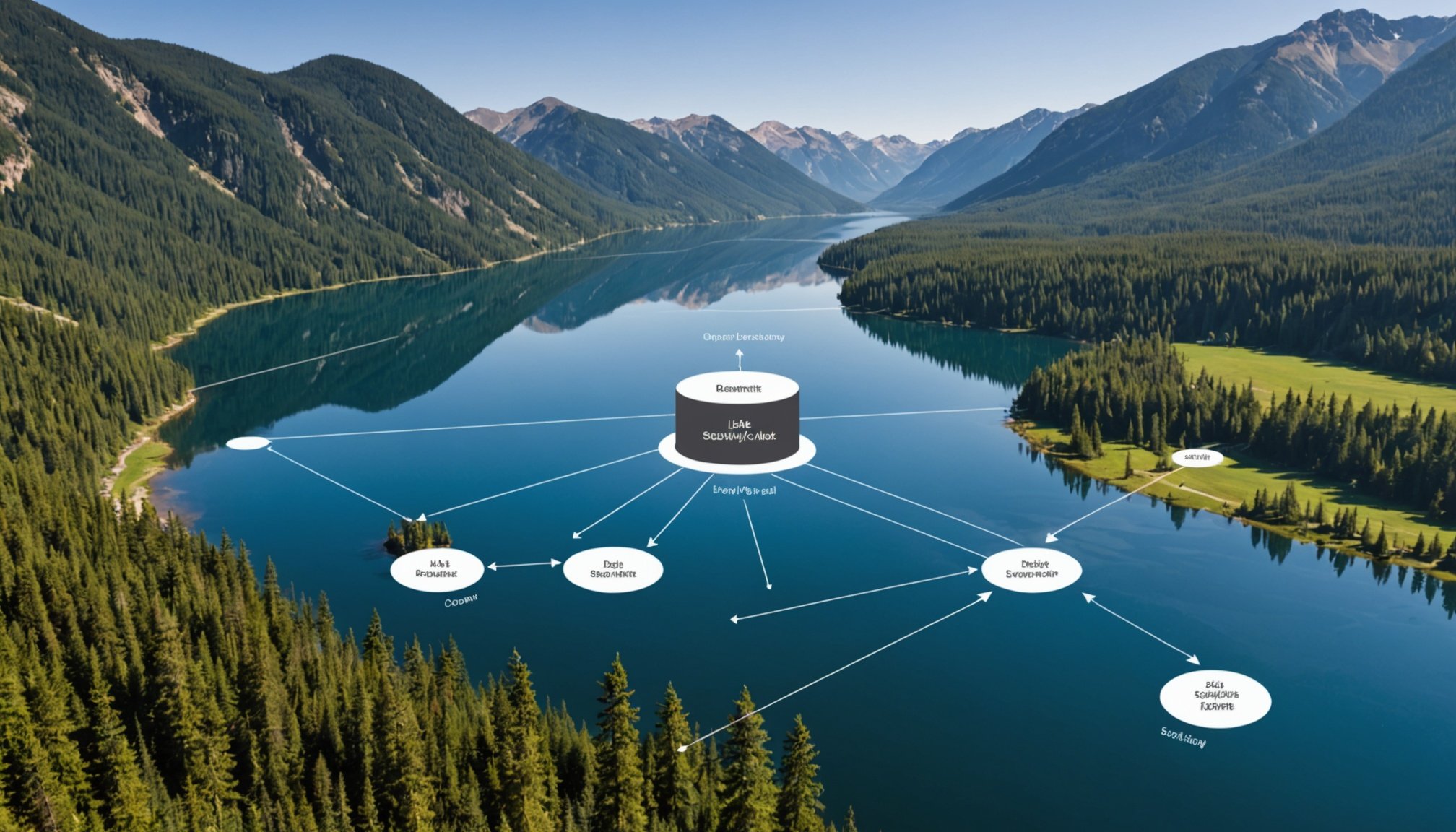Key Design Elements for a Secure Data Lake
Creating a data lake design with built-in security is crucial for safeguarding sensitive information. Incorporating security measures in the initial design phase not only prevents breaches but ensures smooth operation as the data volume grows. Essential components must be considered to ensure a robust and reliable data lake architecture.
Implementing security protocols at the outset fortifies the system against potential threats. Common security protocols include encryption, which protects data at rest and in transit, and access control measures that regulate which users can interact with different datasets. This approach helps to manage risks effectively and maintain data integrity.
This might interest you : Enhancing ai performance: effective techniques for streamlining efficiency in iot networks
Moreover, a scalable architecture is vital to accommodate future growth without compromising security. By designing with scalability in mind, organisations can optimise system performance and maintain data safety as the volume and complexity of data increase.
Evaluating security needs early and integrating them into the overall structure results in a data lake that reliably serves business needs while securing sensitive data. Such comprehensive planning helps in aligning with industry standards and meeting regulatory requirements.
Finally, adopting a layered security approach, incorporating network security, data encryption, and user authentication, ensures a robust data lake environment, prepared to face evolving threats and data security challenges.
Understanding Data Governance in a Data Lake Context
Data governance is critical in a data lake environment, ensuring that data is managed effectively and used responsibly. A robust data governance framework is essential for maintaining data integrity and quality, guiding how data is collected, stored, and utilised. Effective governance helps align processes with business objectives and regulatory requirements.
Importance of Data Governance Framework
A well-defined data governance framework establishes roles and responsibilities, ensuring accountability and clear policies for data management. It encompasses data quality, data usage policies, and helps in ensuring compliance with regulations such as GDPR and HIPAA. By embedding governance early in the design, organisations can better manage risks and enhance data management practices.
Role of Metadata in Data Management
Metadata plays a pivotal role in the effective management of a data lake, providing insights into data lineage and usage patterns. It enhances data discovery, enabling better decision-making. Managing metadata effectively ensures that data is accessible and comprehensible, significantly improving the efficiency of data governance initiatives.
Ensuring Regulatory Compliance
Understanding and adhering to regulatory compliance is vital. Data governance strategies should consider existing regulations, offering a comprehensive approach to compliance. This includes regular audits and adapting policies to meet evolving standards, ensuring the organisation remains compliant with laws governing data protection.
Scalability Considerations for a Data Lake
In the context of a data lake, ensuring scalability is crucial for long-term success. As data volumes increase, the system should be capable of adjusting accordingly without a hitch. A scalable architecture facilitates this growth, maintaining performance and functionality.
When assessing scalability needs, consider future data influx, user demands, and system performance optimization. Address potential bottlenecks early to prevent issues as data grows. Using scalable cloud solutions enables flexibility, as resources can be adjusted based on real-time demands.
Performance optimization often involves monitoring data processing speeds and storage efficiency. Techniques such as data partitioning, indexing, and load balancing help in maintaining smooth operations. Additionally, implementing resource allocation strategies ensures that workload is distributed evenly, enhancing the system’s responsiveness.
Balancing scalability with cost management is another critical aspect. While expanding infrastructure can be costly, allocating resources wisely and optimizing system architecture can mitigate unnecessary expenses. Evaluate and select technology solutions based on their ability to provide a return on investment.
Ultimately, addressing scalability effectively requires an adaptable plan, balancing both technical capabilities and cost considerations to facilitate seamless growth as data landscapes evolve.
Best Practices for Implementing a Secure Data Lake
Establishing a secure data lake requires a comprehensive approach that follows established best practices and implementation strategies. A strategic, step-by-step guide is essential for successful deployment.
Step-by-Step Guide for Successful Deployment
-
Define Objectives and Scope: Clearly outline the purpose of the data lake and what you aim to achieve. This clarity informs the structure and functionality of the deployment.
-
Select Appropriate Technologies: Choose solutions that meet the specific needs and budget of your organisation. Prioritise flexibility and scalability alongside cost-effectiveness.
-
Incorporate Security Measures: Integrate robust security measures from the outset, including encryption and access controls, to mitigate risks and safeguard sensitive data.
User Training and Awareness
User education is crucial in maintaining security. Regular training sessions ensure that users understand the importance of security protocols, such as encryption and access control. Awareness campaigns can significantly reduce human errors, which are often the weakest link in security systems.
Real-World Case Studies
Examining successful examples offers valuable insights. Case studies highlight effective practices, common pitfalls, and innovative solutions that enhance both security and functionality in real-world settings. This perspective aids in anticipating challenges and developing a proactive strategy.
Cost Management Strategies for Data Lakes
Implementing a data lake involves thoughtful planning to optimise costs from inception through to ongoing operations. Effective cost management ensures the data lake maintains its functionality and value without overwhelming an organisation’s budget.
Budgeting for Initial Data Lake Setup
Initial setup costs include infrastructure, software, and personnel. By prioritising budget optimization, organisations can allocate resources efficiently, selecting cost-effective technology that meets both current and future data management needs. Understanding these costs upfront helps to avoid overspending and aligns with strategic objectives.
Managing Ongoing Operational Costs
Once a data lake is operational, it’s essential to manage costs such as storage and processing expenses. Implementing resource-efficient strategies, like tiered storage solutions, helps control these expenses. Regular audits and performance assessments can identify areas for further budget optimization, ensuring the data lake remains financially sustainable.
Cost-Effective Technology Choices
Selecting appropriate technology is critical for controlling long-term costs. Balancing performance with cost management involves evaluating technologies that offer scalability and integration flexibility. Ensuring technology choices can adapt to evolving demands reduces costs over time and maximises return on investment. By focusing on resource allocation, organisations can future-proof their data lake infrastructure and maintain cost-effective operations.
Future Trends in Data Lake Security and Design
Navigating future trends in data lake security and design is critical for staying ahead in the evolving data landscape. The integration of emerging technologies promises profound impacts on how data lakes are constructed and secured.
Emerging Technologies Impacting Data Lakes
The influence of emerging technologies on data lakes is set to transform architecture and security dynamics. Innovations like serverless computing offer scalable solutions, enhancing flexibility and efficiency. Blockchain technology introduces immutable ledgers, bolstering data integrity.
Anticipated Regulatory Changes
With increasing data privacy concerns, regulatory changes are inevitable. Organisations must anticipate amendments in existing laws, such as GDPR and HIPAA, to ensure ongoing compliance. This proactive approach aids in embedding responsive data protection measures within the infrastructure.
The Role of Artificial Intelligence and Machine Learning
Artificial Intelligence (AI) and Machine Learning (ML) are revolutionising security protocols. AI-driven analytics enhance threat detection processes, identifying vulnerabilities swiftly. ML algorithms optimise data management, streamlining operations while maintaining security across data lakes. These tools empower businesses to tackle future challenges effectively, fostering a secure and robust data environment.











